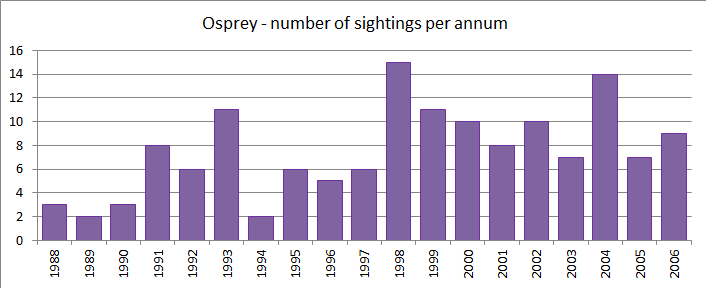Pandion haliaetus
Scarce passage migrant.
The Osprey has a worldwide breeding distribution, being absent only from the Polar regions. It is a summer visitor in temperate zones, north European birds wintering as far south as Africa.
The Osprey was formerly a rare bird in Pembrokeshire. Mathew (1894) knew of no occurrences but I. K. Morgan, while researching natural history matters in Carmarthenshire, unearthed the record of a specimen taken at Fishguard about 1842. It was documented in the unpublished papers of L. W. Dillwen. Another Osprey was recorded at the Pembroke River in 1904 (Lockley et al, 1949). Ospreys became extinct as a breeding bird in Britain post 1908 but began to recolonise Scotland in the early 1950’s. Numbers built up to reach 72 pairs by 1991 and 184 pairs by 2004. A few have nested in England and Wales.
Just one Osprey was recorded in Pembrokeshire during the time of breeding extinction in Britain, at the Pembroke River in September 1931. The re-establishment of the British breeding population had a discernable effect on occurrences in Pembrokeshire, being recorded in just one year in the 1960’s, then in two years in the 1970’s and in six years in the 1980’s. From the time that the Scottish population reached 50 pairs in the late 1980’s Ospreys became of annual occurrence in Pembrokeshire and the number of birds involved increased.
Number of birds per annum, 1988 – 2006.

Most records refer to birds passing through but some have lingered at good food sources for days, more so in autumn than in spring.
Cumulative monthly totals, 1966 – 2006.

Spring records span the 4th March to the 28th June, autumn records from the 17th July to the 25th October, with a single occurrence in December at the Teifi Estuary on the 18th in 2000.
Attracted to waters where they can catch fish, Ospreys have been recorded from many places around the coastline, including the larger offshore islands, from all of the estuaries and from all the main rivers up to the headwaters, and bodies of water like Llys y fran Reservoir, Heathfield Gravel Pit and Clarydale, even prospecting small ponds at Troopers Inn and Wiston.
Graham Rees
(Covers records up to and including 2006).
References
LOCKLEY. R. M, INGRAM. C. S. and SALMON. H. M.1949. The birds of Pembrokeshire, West Wales Field Society.
MATHEW. M. 1894. The birds of Pembrokeshire and its islands, R. H. Porter.
 Saturday, August 31, 2013 at 10:21AM
Saturday, August 31, 2013 at 10:21AM 



